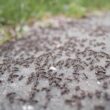What if you went to check on your beautiful tomato plants and found them looking like they went through a blender overnight? Half-eaten tomatoes scattered on the ground, stems chewed down to nubs, and mysterious hoof prints in the soil.
If you’ve ever grown tomatoes, you’ve probably wondered whether deer are the culprits behind this garden crime scene.
Do Deer Eat Tomatoes?
The answer is clear: deer absolutely do eat tomatoes. Both the fruits and the plants themselves are fair game when deer visit your garden. They’ll munch on ripe tomatoes hanging on the vine, chew through green tomatoes, and even eat the leaves and stems of your plants.
But here’s the important part: tomatoes aren’t on deer’s preferred food list. These animals are opportunistic feeders who normally go for other plants first. Your tomatoes become a target mainly when their favorite foods aren’t available or when they’re particularly hungry.
Think of it this way: if deer had a restaurant menu, tomatoes would be toward the bottom of the list. They’d rather eat your beans, lettuce, strawberries, and sweet corn first. But when those preferred options are gone, your tomatoes look pretty appealing.
When Deer Target Your Tomatoes
Deer turn to tomato plants in specific situations:
- Food gets scarce: During droughts, harsh winters, or when their favorite plants are gone
- Competition is high: When too many deer are competing for the same food sources
- Natural foods disappear: Late in the season when their preferred plants have died back
- Suburban living: In developed areas where wild food options are limited
- Young deer: Juvenile deer are more likely to test new foods, including tomatoes
When food is scarce, deer eat just about anything, including prickly-stemmed okra and hot peppers. So your tomatoes definitely aren’t safe when deer get desperate.
Research shows that crops like tomatoes make up only about 4% of a deer’s natural diet. The majority of what they eat consists of woody plants (46%), broad-leaved plants like wildflowers (24%), and nuts and seeds (11%). This explains why your tomatoes aren’t usually their first choice, but it also shows why they’ll eat them when better options aren’t around.
Seasonal Patterns
Deer eating habits change throughout the year, which affects when your tomatoes are most at risk:
Spring and Summer: They prefer fresh, new growth. Young plants and tender shoots are like candy to them. Your tomato plants might be more vulnerable when they’re young.
Fall: Acorn season! If there are oak trees around, deer will mostly ignore other food sources to focus on these nutritious nuts. This might actually protect your late-season tomatoes.
Winter: They rely more on woody browse and their stored fat reserves. Not typically tomato season anyway.
Drought periods: All bets are off. They’ll eat whatever they can find, including your tomatoes.
The Tomato Plant Toxicity Factor
Here’s where things get interesting. Tomatoes belong to the nightshade family, which includes potatoes, eggplants, and the famously poisonous deadly nightshade. These plants have natural defense systems built right in.
While tomato plants aren’t inherently toxic to deer, the leaves and stems contain alkaloids (solanine and tomatine) which can be toxic in large quantities. However, the levels in ripe tomatoes are pretty low and not likely to pose a significant health risk to deer.
Think of these alkaloids as the plant’s way of saying “Hey, don’t eat me!” The compounds make the plant taste bitter and can cause stomach upset if eaten in large amounts. Most deer naturally avoid plants with these compounds because they can sense that something’s not quite right.
But here’s the catch: when deer are really hungry, they’ll push through that natural aversion. It’s like eating food that’s past its expiration date when you’re starving. You know it’s not ideal, but you’ll do it anyway.
How to Tell if Deer Are Eating Your Tomatoes
Before you start blaming deer for your tomato troubles, make sure they’re actually the culprits. Here’s how to play detective:
Look for Physical Evidence
Hoof prints: Deer prints look like upside-down hearts. In soft soil, you might not see the actual print but instead notice deep, almost cylindrical holes poked into the ground.
Droppings: Look for small piles of round, pebble-like droppings scattered around your garden.
Trampled plants: Deer are big animals with big feet. They’ll leave obvious signs of their clumsy movements through your garden.
Check the Damage Pattern
Bite marks: Deer-damaged foliage has a rough, jagged edge because deer lack upper incisor teeth. They bite down on a leaf and pull, leaving behind a ragged remnant.
Height of damage: Deer are tall, so damage typically occurs higher up on plants compared to rabbit or rodent damage.
Whole plant destruction: Deer take a bite out of ripe tomatoes or eat whole fruit, depending on the size. They’re not delicate about it.
Don’t Confuse Deer with Other Pests
Rabbits: Leaf damage caused by rodents, such as rabbits and chipmunks, has a regular, straight margin. Their cuts look clean and precise.
Insects: Insect damage usually appears as small holes or chewed edges, much different from the large, rough damage deer cause.
When Deer Are Most Likely to Strike
Understanding deer behavior can help you predict when they’re most likely to visit your garden.
Daily Patterns
Deer are crepuscular, which is a fancy way of saying they are most active during those twilight hours of dawn and dusk. Peak feeding time is early morning and late evening.
This means your tomatoes are most vulnerable:
- Early morning: Between 6:00 AM and 10:00 AM
- Late evening: Between 4:00 PM and 7:00 PM
- Throughout the night: When you’re fast asleep
Seasonal Vulnerability
Your tomatoes face the highest risk during:
- Late summer: When other food sources start to decline
- Drought periods: When natural vegetation is stressed or dead
- Fall: When deer are building up fat reserves for winter
- After storms: When deer emerge hungry after taking shelter
How to Protect Your Tomatoes
Now for the good news: there are plenty of ways to protect your tomato plants from deer. The key is using multiple methods together, because no single approach is 100% effective.
Physical Barriers
Fencing: This is the most reliable method, but it needs to be done right. Most traditional landscape fences won’t keep out deer. These large, agile creatures can easily jump a standard 4-foot-tall fence. The best deer fence is 8 feet tall.
Don’t have space or budget for an 8-foot fence? Research has shown that deer are regularly deterred by a 16-foot square fence that’s only 4 feet tall. Wildlife specialists have found that deer avoid entering small spaces because they perceive the small space as being too risky for fast entry and exit.
Individual plant protection: Surround each tomato plant with a cage made of wire or deer netting. This works especially well for container plants or small gardens.
Raised beds: Elevating your tomato plants makes them less accessible and less appealing to deer.
Natural Deterrents
Companion planting: Plant companion vegetables and herbs that deer rarely browse due to their prickly texture or pungent odor near tomato plants. These include chives, cucumbers, eggplant, leeks, onions, rosemary, rhubarb, and sage.
Think of these plants as bodyguards for your tomatoes. Plant them in a border around your tomato patch, and their strong scents and textures will help keep deer away.
Aromatic plants: Deer can’t stand toxic plants like daffodils, foxglove, and poppies; highly fragrant plants like sage, mint, garlic, salvia, lavender, peonies, and bearded irises; or fuzzy and thorny plants like roses, lamb’s ear, and spirea.
Scent-Based Deterrents
Commercial repellents: Research at the USDA/National Wildlife Research Center has shown that repellents that emit sulfur odors, like those found in egg products or bloodmeal, provide the best control.
The key with any repellent is consistency. You can’t spray once and forget about it. Plan to reapply weekly, especially after rain.
Soap: Having a bar of very fragrant bath soap nearby can keep deer from browsing your tomatoes. Use an individually wrapped, highly fragrant small bar. Leave the bar wrapped and drill a small hole through the soap. Thread a piece of yarn through the hole and hang the bar on a stake near a tomato plant.
Human hair: Ask your barber or hairdresser for hair clippings. The scent of human hair can act as a deterrent when scattered around your garden or stuffed into old pantyhose and hung around the area.
Motion-Activated Deterrents
Sprinkler systems: Motion-activated sprinklers are a great way to spook deer out of your garden. Simply adjust the sprinkler head detector to face the oncoming traffic and it’ll pick up a 1600-square-foot area.
Lights: Motion-activated lights startle deer and make them feel exposed to predators.
No products found.
Noise makers: Alarms, radios, or ultrasonic devices can scare deer away. Just remember to change up the sounds periodically so deer don’t get used to them.
Habitat Modification
Remove hiding spots: Trim back tall grass and dense shrubs around your garden. Deer like to feel safe, and if they can’t find good cover nearby, they’re less likely to venture into your garden.
Strategic placement: Plant your tomatoes close to your house or in areas with regular human activity. Deer are naturally wary of people and avoid areas where they might encounter humans.
Rock barriers: You can take larger rocks and place them in a thick band around your garden bed, and the deer will not go inside the bed. Deer do not like walking over large rocks to access something, so they simply will not do it.
Advanced Protection Techniques
If basic methods aren’t working, here are some more sophisticated approaches:
The Fishing Line Trick
String fishing line around the perimeter of your garden at varying heights, targeting a deer’s chest or neck level. As deer enter your garden, they encounter the fishing line without warning. This sudden touch, caused by the line brushing against their fur, startles them because they can’t see it.
Predator Deterrents
Dog presence: A barking dog is a good deer deterrent, but only if it has free range in the yard and doesn’t bark incessantly. Deer quickly figure out if a dog poses a true threat, and will ignore non-stop barkers and dogs that are corralled in a run separate from the garden.
Predator urine: Predator urine gives deer a fright by making them think a predator visits your garden. Note that liquid urine requires frequent application and can be expensive for treating a large garden.
Why Some Methods Don’t Work
Understanding why protection methods sometimes fail can help you avoid frustration:
Deer Get Used to Things
Deer are smart animals. If you put up the same scarecrow every day, they’ll eventually figure out it’s not a threat. This is why rotating your deterrent methods is so important.
Desperation Overrides Fear
When deer are really hungry, they’ll push through their natural fears and aversions. A starving deer will eat plants it normally wouldn’t touch and brave deterrents that would usually send it running.
Young Deer Are Rebellious
Young deer taste everything and older deer devour anything they like. Juvenile deer are more likely to test new foods and push boundaries, just like teenagers.
Creating a Comprehensive Protection Plan
The most successful gardeners use multiple protection methods together. Here’s how to create a layered defense:
- Start with the basics: Install proper fencing or individual plant cages
- Add companion plants: Surround your tomatoes with deer-resistant plants
- Apply repellents: Use commercial or homemade deterrents consistently
- Install motion deterrents: Add sprinklers, lights, or noise makers
- Modify the habitat: Remove cover and create barriers
- Stay flexible: Be ready to adjust your approach based on what works
When to Get Professional Help
Sometimes DIY methods aren’t enough. Consider calling in professionals if:
- You’re losing significant amounts of your harvest consistently
- You have a large deer population in your area
- Multiple methods have failed
- The deer are causing damage beyond just eating plants
Professional wildlife control specialists can assess your specific situation and recommend targeted solutions.
The Bottom Line
Yes, deer do eat tomatoes, but they’re not usually the first choice on the menu. Tomatoes are notably not on the preferred plant list for deer, but these animals can be unpredictable and may take a few bites of pungent tomato foliage or ripe fruit if other food sources are limited.
The good news is that with the right combination of protection methods, you can keep your tomato plants safe and still enjoy a great harvest. Remember that no method is 100% effective, and success requires consistency and patience.
Start with proven methods like fencing and repellents, add some companion plants, and be prepared to adjust your approach as needed. Most importantly, don’t get discouraged if you lose a few tomatoes along the way. Even experienced gardeners deal with deer damage from time to time.
Your tomatoes are worth protecting, and with the right strategy, you can outsmart even the hungriest deer. Happy gardening!


